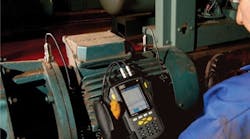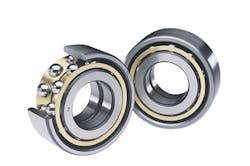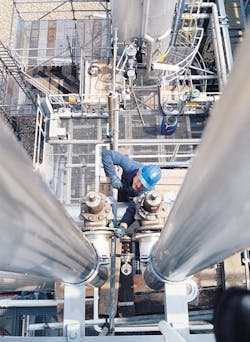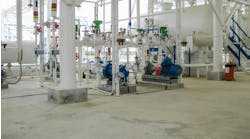Achieve Optimum Centrifugal Pump Performance
|
Related articles Properly protect centrifugal pumps |
Centrifugal process pumps often must perform in hostile and stressful operating conditions. As a result, the likelihood of their premature failure increases over time — raising risks of incurring considerable costs and lost productivity from downtime. With pressures mounting to achieve better pump reliability, reduced maintenance and lower energy consumption, the quest to identify and implement viable solutions for relief ranks as a top priority.
Evaluating pump maintenance and repair practices — paying particular attention to bearings, lubrication and seals — can serve as a crucial tool for attaining higher levels of pump reliability and longer service life. The proper bearings, lubricants and sealing systems can boost economies and efficiencies and, when supported by proactive condition-monitoring approaches, can help extend the service life of pumps and minimize the need for untimely pump replacement or rebuilds.
Selecting the bearings
Bearings in centrifugal pumps support hydraulic loads imposed on the impeller, the mass of the impeller and shaft, as well as loads due to couplings and drive systems.
They also keep the shaft axial and radial deflections within acceptable limits for the impeller and shaft seal.
A variety of conditions tend to continually put bearings in many centrifugal pumps to the test. The bearings often will face high axial loads, marginal lubrication, and high operating temperatures and vibration, all while the bearings attempt to minimize friction — which, if uncontrolled, can result in power loss, excessive heat generation, increased noise or wear, and early bearing failure.
All these influences can dramatically impact the service life and reliability of bearings and, in turn, pumps. So, first and foremost, evaluate bearings (types, designs and arrangements) in the context of their anticipated operating environment.
Suitable bearings are available to satisfy even the most difficult conditions faced by centrifugal pumps. As an example, thrust-type bearings (to support axial loads created by hydraulic forces in the pump) include various versions of angular contact ball bearings that suit many applications:
Single-row 40° angular contact ball bearings. These are the most popular API pump thrust bearings in service today and generally are used in moderate-speed centrifugal pumps where high thrust loads can be expected.
Variations designed with robust machined brass cages suit applications where thrust loads vary greatly during operation and periods of ball skidding are likely. These bearings also will resist destructive vibration forces should cavitation occur. They normally are mounted in back-to-back paired arrangements to accommodate reversing thrust loads and to provide adequate shaft support to promote long mechanical-seal life.
Pay particular attention to internal clearance. When mounted and at operating temperature, the bearings should have enough residual internal clearance to operate cool but not so much as to promote skidding of the inactive bearing.
Double-row angular contact ball bearings. These (Figure 1) are used extensively as the primary thrust bearing in ANSI standard centrifugal pumps and some older API-style pumps. The most effective types feature a Conrad-design, ABEC-3 precision tolerances, a 30° contact angle per row, one-piece heat-treated pressed steel cages, and multiple sealing options. Because their contact angles diverge outwardly, the bearings exhibit greater rigidity and increased resistance to misalignment. As with paired single-row angular contact ball bearings, operating conditions dictate the need for normal or greater-than-normal (C3) internal radial clearance.
Figure 1. ANSI standard pumps typically rely on such bearings to handle thrust loads.
Design variations are becoming more popular. Examples include steeper (40°) contact angles to deliver increased thrust capacity, machined brass cages to offer robust performance under heavy-duty and poor-lubrication conditions, reduced axial internal clearances to promote load sharing between the two rows of balls and a reduced possibility of skidding in the inactive ball set, and ABEC-3 (P6) tolerances to contribute better control of the bearing’s mounted condition and smoother bearing operation.
Specialized angular contact ball bearing sets. For pumps with minimal thrust, paired 15° angular contact bearings generally suffice. However, for high-thrust-load conditions, use high-performance matched sets of 40° and 15° angular contact ball bearings to provide improved robustness by reducing the susceptibility of ball skidding in the inactive bearing. These designs are intended for centrifugal pumps that don’t reverse or only periodically reverse.
The primary benefit of these sets is that the 15° bearing is designed with considerably less internal clearance than the 40° bearing, making it less susceptible to centrifugal and gyroscopic forces producing ball sliding and shuttling, while providing additional radial stiffness to maintain integrity of the shaft and seals.
Split-inner-ring angular contact ball bearing sets. These, by matching a single-row 40° angular contact ball bearing with a split-inner-ring ball bearing or four-point contact ball bearing, are designed to accommodate thrust loads in either direction. This arrangement commonly is used in vertical pumps to handle the primary thrust load but also can be utilized in horizontal arrangements, provided the loading is such that the split-inner-ring bearing doesn’t support radial load on its own.
Because two bearings acting in tandem share the thrust load, this arrangement offers an extremely high thrust-carrying capacity. Reversing thrust load can be accommodated on the backside of the split-inner-ring bearing. These two-bearing sets behave like “triplex” sets with the added advantage of saving space and costs.
Supplying the lubrication
Proper lubrication for pump bearings is essential for reliable service — improper lubrication accounts for more than 30% of bearing failures, according to some studies.
Good lubricants primarily provide a separating film between a bearing’s rolling elements, raceways and cages to prevent metal-to-metal contact and undesired friction that otherwise would generate excessive heat that could cause wear, metal fatigue and potential fusing of the bearing contact surfaces. Adequate lubrication for bearings also acts to inhibit wear and corrosion and help guard against contamination damage.
The common methods for the effective lubrication of pump bearings include:
Grease. Easy to apply, grease can be retained within a bearing’s housing and provides extra sealing protection. Depending on the rotational speeds and operating temperatures, relubrication may be required to combat short grease life.
When the operating conditions allow, “greased-for-life” bearings, which eliminate requirements for relubrication and related maintenance tasks, can offer an attractive alternative.
Oil bath. This option establishes an oil level at the center of the bearing’s bottom rolling element and represents the comparative baseline of bearing friction among the lubrication methods. Best results over time can be achieved using a constant-level oiler.
Oil ring. In this method, an oil ring is suspended from the horizontal shaft into an oil bath positioned below the bearings. The rotation of the shaft and ring flings oil from the bath onto the bearings. The lower oil volume in the bearing reduces the viscous friction in the bearing system to allow higher shaft speeds and better cooling.
Oil mist and air-oil. Here, oil is atomized and carried by an air stream to the bearing. Among all pump bearing lubrication approaches, this one generates the least amount of friction (allowing rotational speed to be based on the bearing design instead of lubrication limitations) and creates a positive pressure within the bearing housing (fending off invasive contaminants).
Regardless of lubrication method, always specify lubricant according to the demands on vertical shafts and resistance to solids, pressure, temperatures, loads and chemical attack. Where pump locations may be difficult to access, fully automatic systems can be integrated to enable timely, proper and effective delivery.
Sealing the system
Bearing seals in centrifugal pumps handle four crucial tasks. They retain lubricants or liquids, exclude contaminants, separate fluids and confine pressure. So, the seals have their work cut out for them. Solid contaminants, depending on particle size, hardness and brittleness, will produce either indentations or wear on the bearing surfaces; water will affect the efficiency of the lubricant; and contamination in the lubricant can dramatically reduce bearing life.
When a seal fails, contamination can infiltrate the bearing area, entering the lubricant and then the bearing. In addition, loss of lubricant from the bearing can lead to dry-running operation, which ultimately can cause bearing failure.
The choice of seal for centrifugal pump bearings depends on the unique demands and operating conditions of the application. Keep in mind, though, that the bearing and sealing arrangement represent an integrated system.
Dynamic radial seals generally are the best choice for centrifugal pumps. These seals create the barrier between surfaces in relative motion (one usually stationary while the other rotates).
Typically, radial shaft seals incorporate:
Steel or elastomer shell. This is bonded to the sealing material and enables the requisite interference fit of the seal in the housing bore to be maintained (as well as facilitates proper installation); and
Elastomer sealing lip. Usually installed against the shaft, this provides dynamic and static sealing against the shaft and features a sealing edge formed by pressing, cutting or grinding. Most sealing lips are made from a formulation of nitrile rubber.
However, materials specifically for use with fuels, industrial fluids and highly compounded lubricants are available.
Seal selection ultimately must be based on a thorough review of application parameters and environmental factors. Particularly in pump applications, for example, seals will be exposed to relatively constant pressure differentials — making pressure seals (in which the seal cavity is pressurized) the preferred choice.
Due to the nature of their design and the harsh operating environment, seals usually provide a much shorter life than the components they protect. So, don’t fall into the common but unfortunate habit of scheduling seal replacement only at intervals dictated by requirements of other components such as bearings. Many bearing failures can be prevented if seals are replaced when the first signs of wear or leakage have been detected.
To get an inkling of how long seals should last, consider the amount of contamination a seal will encounter, cycle times, speed and heat. Of course, contamination isn’t the only reason for premature seal failures. Others culprits can include:
- poor selection;
- improper installation, resulting in leakage; and
- change of lubricant, causing adverse reactions in common sealing materials.
To head off problems, institute a rigorous seal inspection and replacement program.
Don’t automatically replace a failing seal with another of the same design. For example, if an oil analysis shows higher-than-anticipated ingress of contaminants, it may be time to upgrade the entire sealing arrangement (perhaps using a more chemically resistant material or adding elements to bolster the sealing system). Or, in cases of excessive wear, it may make sense to switch to a non-contact labyrinth seal design.
Monitoring pump health
Taking a more proactive approach to pump maintenance can play an important role in boosting uptime. So, it’s not surprising there’s increasing interest in condition monitoring. This involves regular measurement and analysis of key physical parameters such as vibration and temperature, and enables detection of pump system problems before they can result in unscheduled downtime, high repair or replacement costs, and lost productivity.
Basic instruments can assess and report on vibration, temperature and other parameters. More advanced tools include online surveillance systems and software that can deliver real-time data for review and foster more timely remedial action should this become necessary.
Many problems will manifest as vibration, which is widely considered the best operating parameter to judge pump-train condition. Vibration can detect problems such as imbalance, misalignment, bearing oil-film instabilities, rolling bearing degradation, mechanical looseness, structural resonance and a soft foundation.
Vibration measurements are quick and fairly non-intrusive because pump equipment remain undisturbed. In addition, established industry standards identify vibration levels for specific types of equipment.
A significant increase in “overall vibration” (the sum of all vibration within the frequency range of the instrument) compared to a baseline value will signal an impending problem, allowing it to be addressed before equipment failure occurs.
A wide range of technologies from hand-held vibration monitoring tools such as low-cost vibration pens and overall vibration meters to more sophisticated portable data collectors and related instruments combining compact size with data storage capabilities (Figure 2) can handle data collection.
Figure 2. This instrument provides a range of testing and analysis techniques as well as data recording.
Regular monitoring of temperature also can shed light on system conditions. It’s a useful indicator of mechanical condition or the load applied to a specific component such as a thrust bearing. For example, as a thrust bearing fails, friction causes its temperature to rise. Thermocouple sensors installed in the housing of a bearing and measuring temperature changes within the bearing or lubricant can send a signal about problems beginning to develop, enabling appropriate maintenance actions to be scheduled.
The technology toolbox for condition monitoring also includes online surveillance systems. These perform round-the-clock monitoring of pumps regardless of their location. Such technology can collect data continuously or at a predetermined frequency from permanently installed sensors and then send its findings to a host computer for subsequent analysis.
Involving the operator
Operators can play a pivotal part in proactive maintenance strategies and boosting pump uptime — by serving as the “eyes and ears” in a plant to detect equipment faults before problems can escalate.
Under Operator Driven Reliability (ODR), the operators perform basic maintenance activities above and beyond their classic duties (Figure 3). ODR enlists operators to observe and record the overall health of pumps by checking for leaks, listening for noises, monitoring temperature, lubrication and vibration, and taking responsibility to identify any abnormal equipment conditions — and, in some cases, to respond with the appropriate corrective actions. Hand-held technology allows operators to translate early detection of developing problems into prompt corrective action.
Figure 3. Operators can serve as a plant’s eyes and ears to detect developing problems.
Operators can monitor:
Bearings. Detecting faults in a bearing’s outer ring, inner ring, rolling elements and cages also can suggest potential problems elsewhere in a pump system.
Lubrication. Spotting under- or over-lubrication within pump bearings can lead to a more-effective lubrication program.
Shaft. Checking pump shafts can uncover imbalance, misalignment, bending, rub, excessive thrust and looseness.
Seal integrity. Watching for leaks and inspecting lubricant cleanliness can provide an indication of the condition of pump seals.
Foundation. Inspecting pump foundations and bases can warn of looseness caused by loose or corroded hardware, deteriorated grouting, base-plate straightness, and pump housing soft- and sprung-foot conditions.
Vane blade pass. It’s important to look for conditions such as wear, blade/vane failure and looseness of shaft fit, as well as contamination and obstructions due to foreign debris within the process.
Impeller clearance. Proper settings are key for optimum performance and represent a good indicator of pump impeller and wear ring conditions.
Cavitation and flow turbulence. Such problems can impact performance and overall pump health over time.
Temperatures. This should involve monitoring several aspects, including bearings, lubrication, sump and the pump housing.
Process parameters. Shaft speed, head pressure, discharge pressure, differential pressure, vacuum, suction, flow, reservoir levels, valve positions and product consistency all deserve attention.
Coupling operator oversight and effective proactive maintenance with proper pump bearings, lubrication and seals can contribute to smoother flowing operations, better performance and service life and, ultimately, optimum uptime.
David R. Mikalonis is sales manager, pump industry, for SKF Industrial Division, SKF USA Inc., Kulpsville, Pa. E-mail him at [email protected].





